Recently, Prof. Cai Zhongyu from the Institute of Precision Instruments and Quantum Sensing, Research Institute for Frontier Science, has published an online article titled “From Colloidal Particles to Photonic Crystals: Advances in Self-Assembly and Their Emerging Applications” in the famous international journal Chemical Society Reviews (2019 impact factor: 42.846). The review article was also selected as the cover article for the current issue. Prof. Cai is both the first author and the corresponding author of the paper. Dr. Teng Jinghua, the co-corresponding author, is the chief scientist of the Institute of Materials Research and Engineering (IMRE) under the Agency for Science, Technology and Research (A*STAR) of Singapore. Other authors include Prof. Serge Ravaine from Centre National de la Recherche scientifique (CNRS), Prof. Song Yanlin from Institute of Chemistry, Chinese Academy of Sciences, and Prof. Yin Yadong from University of California, Riverside, etc.
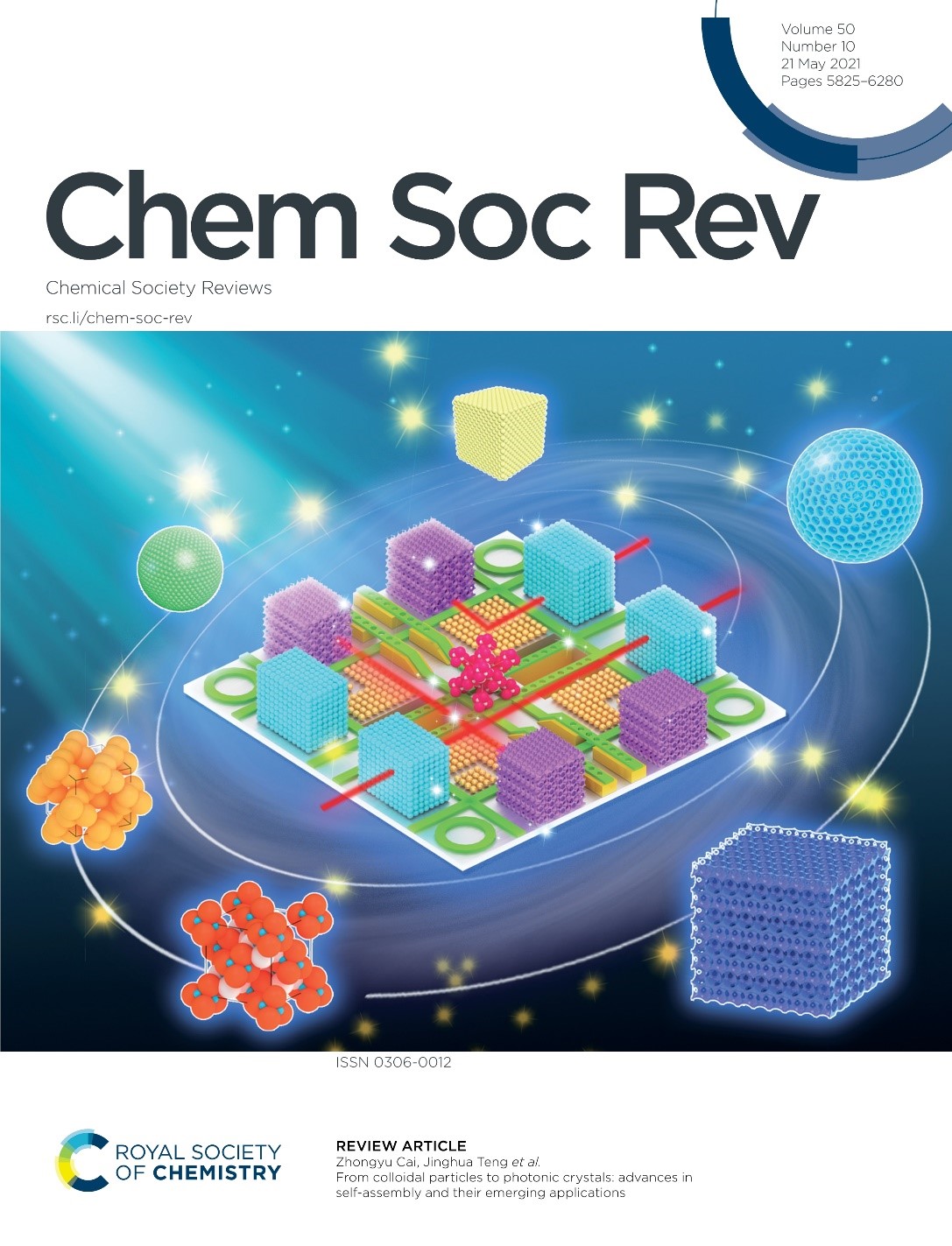
Photonic crystals (PhCs) are a class of novel optical materials, in which the dielectric materials are spatially and artificially organized into a periodic structure. One of the extraordinary properties of a PhC is that it features a photonic bandgap (PBG), in which electromagnetic waves having energy within this band gap are prohibited from propagating through the PhCs. Due to the existence of PBG, photonic crystals have excellent performance of photonic manipulation. The PhCs with a porous structure are also widely used in metamaterials, stealth materials, optical sensing, environment, and energy storage. Therefore, PhCs attract intense interests from the scientific community. In 1998 and 1999, Science has twice rated the research on PhCs as one of "the top ten scientific progress" in the world, and predicted it as one of the six research hot spots in the future. In 2006, PhCs were again rated by Science as the hot spot of natural science in the future.
How to produce high-quality PhCs with high efficiency is a big challenge for its wide application. Generally, these structures can be fabricated via either “top-down” lithographic or “bottom-up” self-assembly approaches. Although traditional “top-down” microfabrication techniques provide precise control over structured defects, they are very tedious, expensive and have trouble in making 3D PhC structures (Fig.1a-c). Therefore, scientists usually explore the “bottom-up” colloidal self-assembly approach for its advantages of low cost and easy operation (Fig. 1d-f).
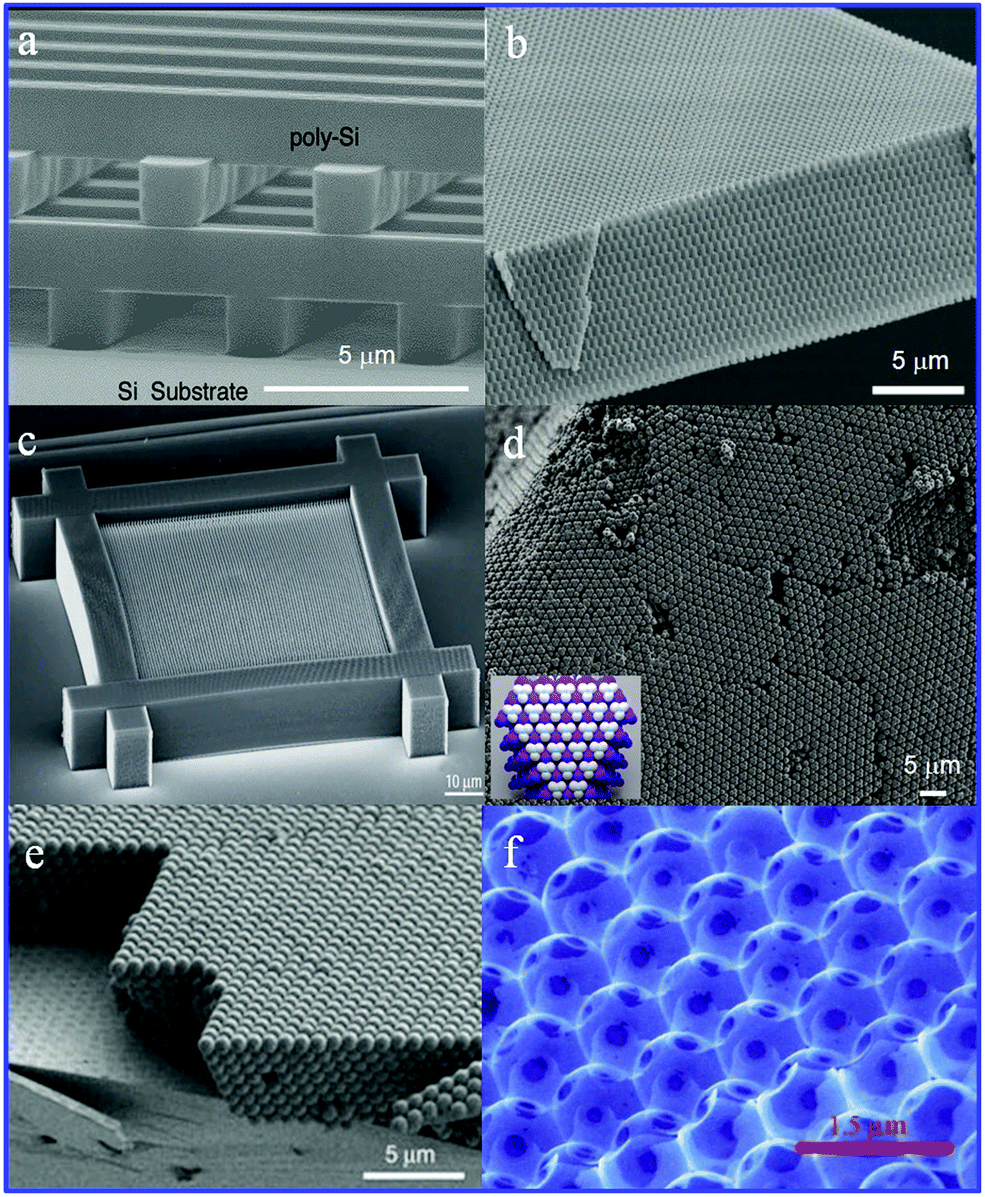
Fig. 1 (a) SEM (scanning electron microscopy) image of a cross-sectional view of 3D PhCs made of polycrystalline silicon (Si) via the photolithographic method. (b) SEM image of polymeric PhCs generated using holographic lithography. (c) SEM image of 3D PhCs fabricated by direct laser writing. Reprinted from Nature Materials, 28 copyright 2004 Springer Nature. (d) SEM image of the (111) plane of diamond-like colloidal PhCs prepared via colloidal self-assembly of patchy compressed clusters. (e) Cross-sectional SEM image of planar colloidal PhCs (synthetic silica opals) prepared via self-assembly. (f) SEM image of internal (111) facet of Si PhCs fabricated with a colloidal crystal templating method.
The self-assembled colloidal crystals (CCs), which are good candidates for PhCs, have offered unprecedented opportunities for photonics, optics, optoelectronics, sensing, energy harvesting, environmental remediation, pigments, and many other applications. However, there are many challenges in the creation of high-quality CCs and their mass fabrication over large areas. All kinds of defects, such as cracks, greatly limit their wide application.
The paper analyzes the various defects encountered in the fabrication process of CCs and the possible mechanism of the formation of cracks/defects for the first time. Several strategies available for the fabrication of high-quality CCs are revealed, and then a range of versatile fabrication methods to create CCs with various structures, such as cubic diamond and pyrochlore structure CCs, are introduced and summarized. In addition, this paper also reviews the fabrication methods of patterned and spherical CCs.
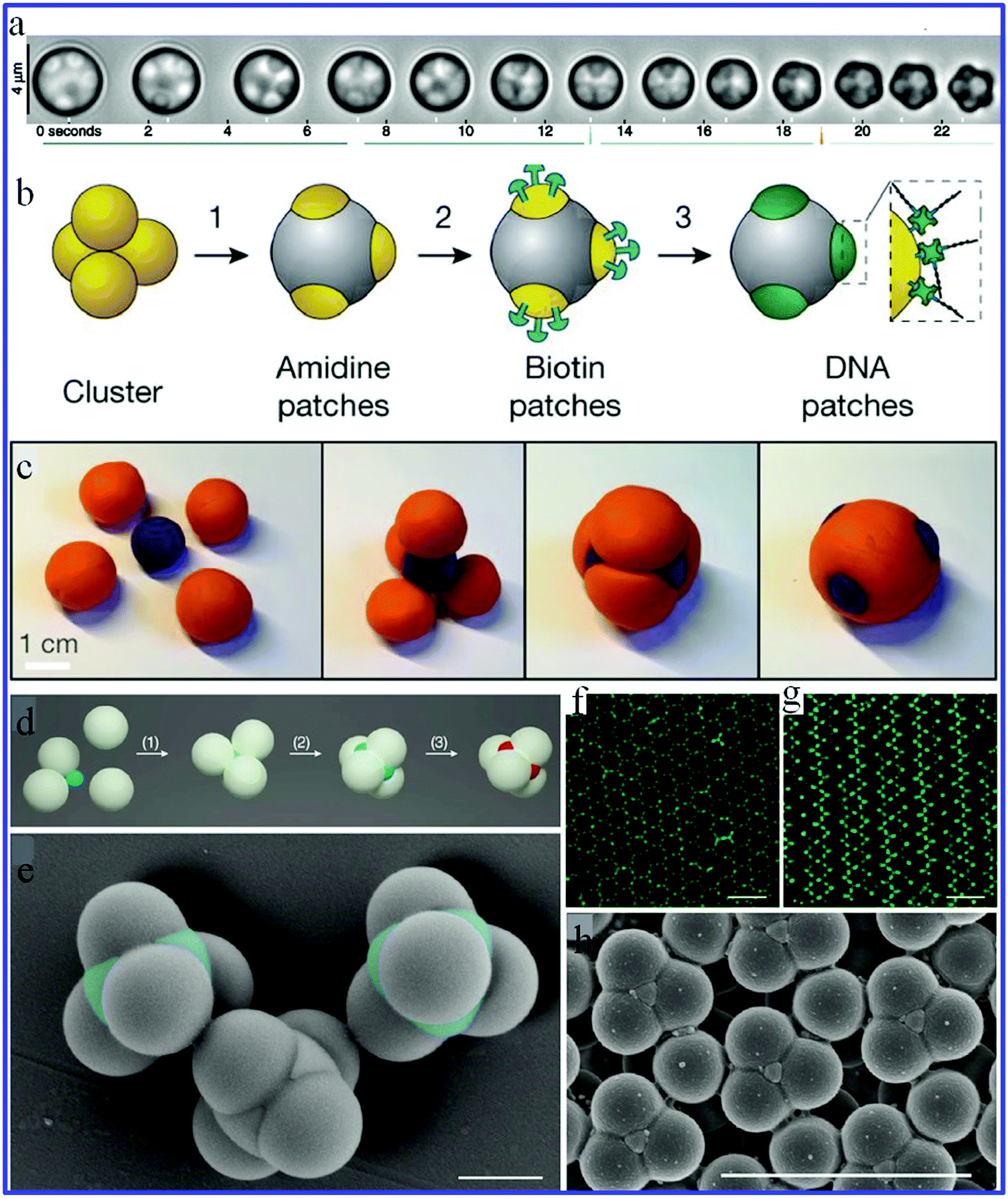
Fig. 2 Self-assembly of colloidal diamond from colloidal patchy particles. (a) Synthesis of colloidal clusters. (b) Synthesis of tetrahedral patchy particles and DNA functionalization of patches. (c) Synthesis of tetrahedral patchy particles by colloidal fusion. (d) Synthesis of tetrahedral compressed clusters. (e) SEM micrograph of partially compressed clusters. Scale bar, 1 μm. (f and g) Confocal micrographs showing the 111 (f) and 110 (g) planes of the self-assembled colloidal diamond. Patches are fluorescently labeled, and spheres are not visible because they are not dyed. (h) SEM micrograph of the self-assembled colloidal diamond by partially compressed clusters.
The paper also put forward a set of practical and feasible theories from the theoretical perspective to guide the development of advanced self-assembly methods to fabricate high-quality CCs, e.g., adjusting the colloidal suspension chemistry, customizing self-assembly substrate properties, and manipulating the thin film drying mechanism (Fig. 3).
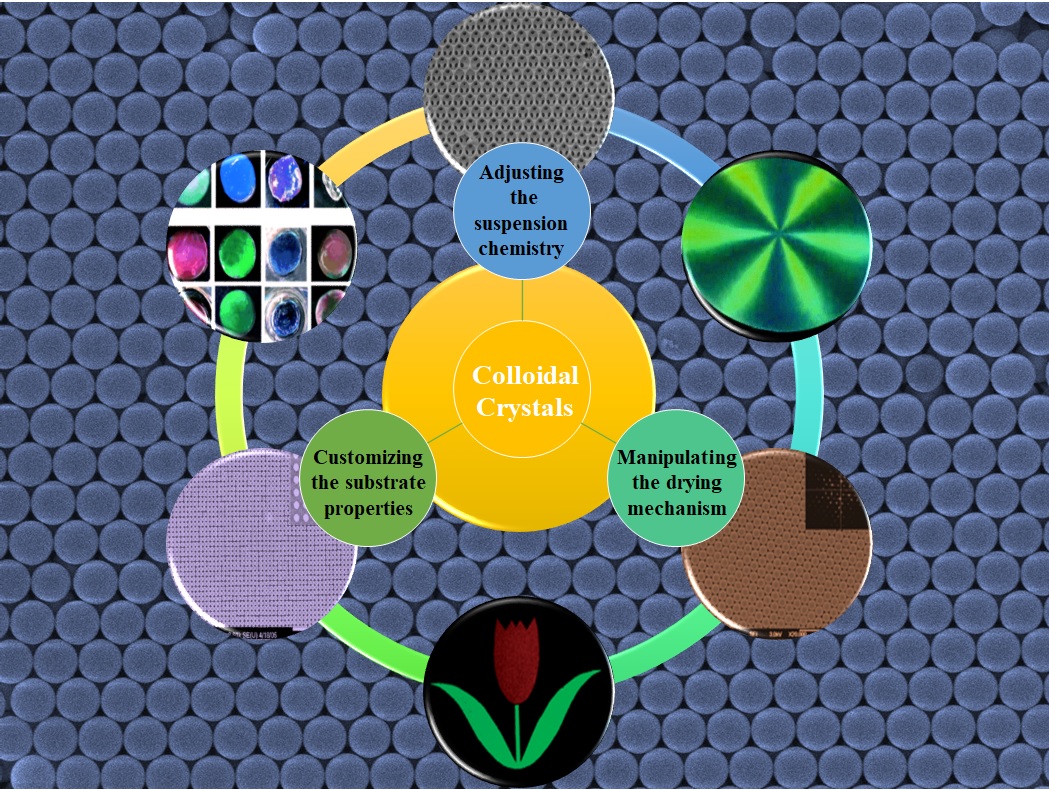
Fig. 3 Several methods to fabricate high-quality CCs.
Based on these mechanisms, researchers have developed various self-assembly methods. In this paper, these methods and their applications are introduced in detail, such as co-assembly, gas-liquid interface self-assembly, atomic layer deposition, chemical vapor deposition, DDNA mediated self-assembly and microfluidic assisted self-assembly. The advantages and limitations of these advanced approaches are also analyzed specifically. As Fig. 4 shows, high-quality silicon-based CCs in large areas are fabricated by the self-assembly method, which can be widely applied in the field of photonic communication.

Fig. 4 Cross-section SEM images of inverse opal structures with layers of 2 (a), 4 (b) and 16 (c) layers. (d) SEM image of the sample edge showing the (100) surface. (e) SEM image showing the planar (111) crystal surface exposed by reactive ion etching (RIE). (f) SEM image showing the (100) crystal surface exposed by RIE.
In addition, the article details some emerging applications of large-area high-quality CCs created by these advanced self-assembly methods, e.g., metasurfaces/metamaterials, displays and LED, novel PhC sensors, biomedical engineering, and others. Figure 5 shows the biomedical applications of spherical photonic crystals, including immunoassay, DNA recognition, ions sensing, drug screening, etc.
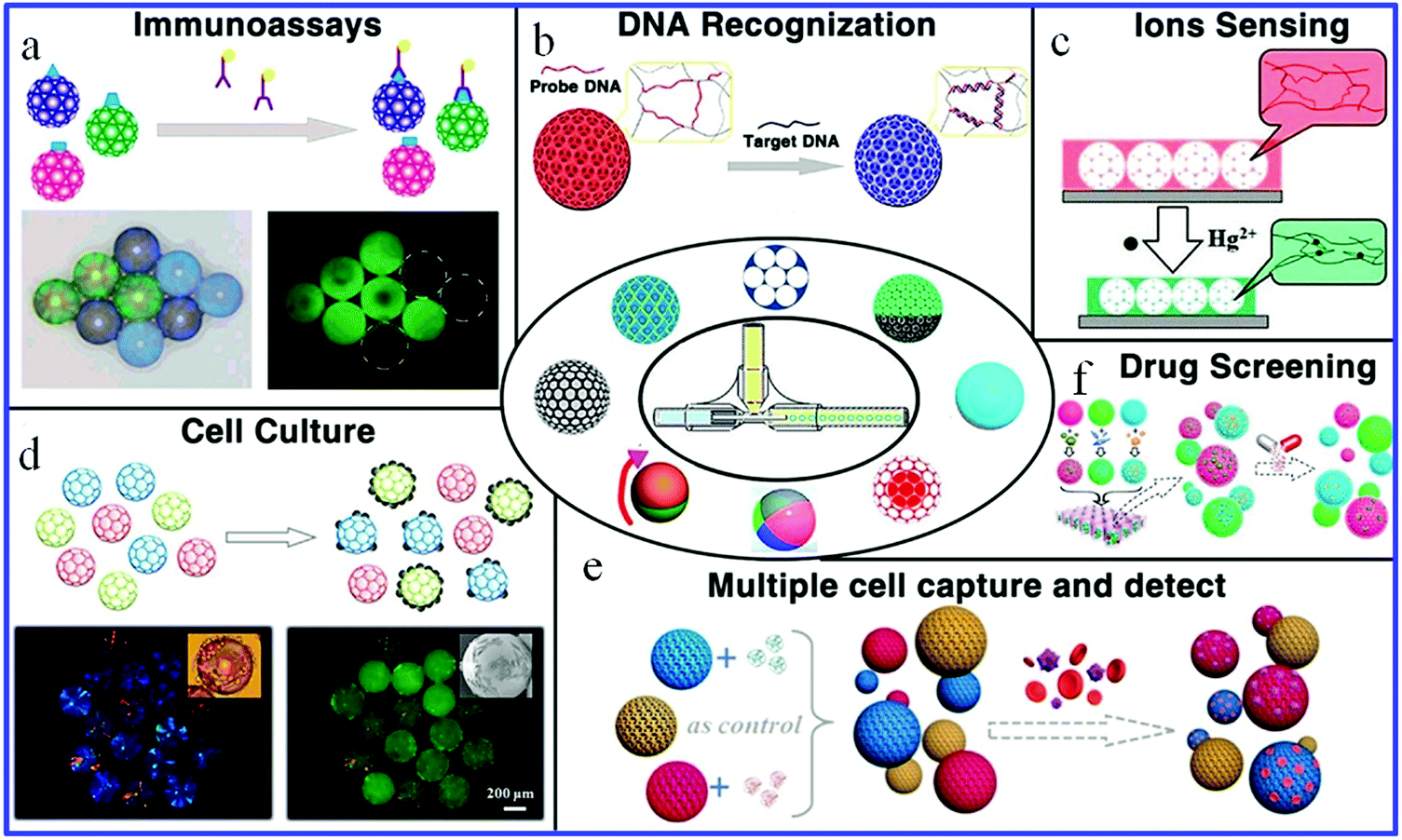
Fig. 5 Multiple photonic crystal microspheres fabricated by a microfluidic system for a variety of applications. Microfluidic system for fabricating photonic crystal microspheres through injecting water droplets containing colloidal particles into flowing oil phase (central scheme).
Prof. Cai has long been committed to the research on the self-assembly of PhCs and their applications in the fields of environment and health. He has made a series of achievements in the fields of PhC fabrication, PhC sensors, photonic photocatalysis and colloidal particle engineering. In recent years, he has published more than 30 research papers in Chemical Society Reviews, Angewandte Chemie International Edition, Chemical Science, Biomaterials, Journal of Materials Chemistry A and other internationally renowned academic journals.
Chemical Society Reviews is a biweekly peer-reviewed scientific journal published by the Royal Society of Chemistry. It is recognized as one of the three most influential and authoritative review academic journals in the fields of chemistry, chemical engineering, and materials in the world, and the papers published by it are of great significance for the related fields.
The link to the article is:
https://pubs.rsc.org/en/content/articlelanding/2021/cs/d0cs00706d/unauth#!divAbstract
Reported by Cai Zhongyu
Reviewed by Wang Fei
Edited by Jia Aiping
Translated by Zheng Quan

